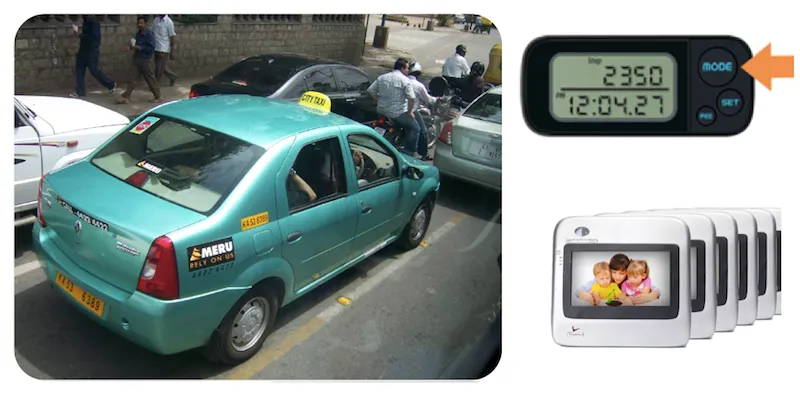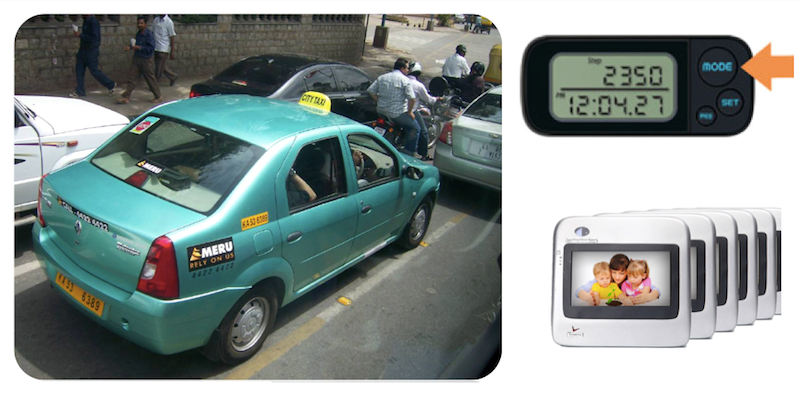Cab service and Hardware: Unusual trends in Indian startups

In the past couple of years, startup activities in India are getting an unusual focus. What was predicted to be "dead on arrival" has become "rock star". Everyone said "when eBay and Amazon are struggling, how would e-commerce companies succeed in India?" Or "when Expedia could not make inroads, how can travel sites succeed in India". Such ‘pundits’ were proved wrong by the success of Flipkart and RedBus (as well as MakeMyTrip).
Luckily, such success stories - Flipkart talking of hundreds of millions of dollars of value and RedBus getting acquired by an international major - ensured that they hog the limelight. But in this story I will outline what is not much written about.
A whole range of ‘cab services’ have sprouted in the past four to five years. Taxi service in India used to be very unorganised. Meru Cabs leveraged the new private sector operated international airports in Delhi, Mumbai, Hyderabad and Bangalore, for example, with a large fleet (5,000+) cars that had absorbed some technology (GPS tracking, Web-based travel booking). There were many followers, including EasyCab, TaxiForSure, Savaari and OlaCabs.
Many of them could exploit the smartphone availability (at least affordable Android phones, if not Apple iPhones) and started using apps to streamline the experience. The streamlined experience includes booking, request, review of options, booking, ticketing, payment, ‘customer loyalty’ programs, and optionally additional services like hotel booking.
Why do I get excited by this development? The fundamental problem in India is the fact that taxi drivers do not make enough money which invariably leads to poor customer service -- taking the customer literally for a ride (longer routes), demanding higher fare, tampering with the meter, and so on. There is no indirect subsidy (the way Singapore does by reduced costs on car and petrol and diesel). Nor are the taxi drivers allowed to charge a higher rate, as the socialist-minded government fixes low tariff so that the end-user is not taxed much.
There is an inherent mismatch due to information asymmetry; the driver does not know that the customer is around looking for a cab and the customer does not know that a cab is indeed around and free to take the customer to the destination.
What these startups creatively do is use GPS to be aware of the passenger and car position (thanks to GPS-enabled smart phones being widely available); GIS to map the roads, landmarks, routes and key destinations; simple algorithms that run on the smartphone to do the first-level matching, route computation and fare calculation; and complex algorithms that run in high-end servers at the back end to do the optimisation; an End-user App to facilitate customer interface and Driver App to facilitate the driver interface. All this magic is possible thanks to affordable servers running on the cloud and mobile telephony infrastructure to connect the cab, driver, customer, smartphone and servers.
The net result is the significant reduction in fare that is made possible. There are startups that talk of less than Rs 5 per kilometre, whereas even the auto rickshaw fare is Rs 12 per kilometre! Such reduced rates are possible thanks to optimising the ‘dead run’ (empty cab running on the road that does not lead to revenue earning by the cab driver).
India’s hardware story
The second trend is that startups are not shying away from hardware. For long, there has been the talk of "India has no chance in hardware, the hardware story is very much the China story". To prove such skeptics wrong, some startups are attempting to do hardware. I am not talking of Micromax and Xolo type of companies who have been manufacturing smartphones. I am talking of GetActive and ExamPad that focus on healthcare and education space.
GetActive from Bangalore-based "2mpower health management" is a USB pen-drive form-factor pedometer that I have been using for the past six months. The device when physically present on your body (pocket, hand, wallet, chain) measures the number of steps, time taken, distance travelled, calories lost and stores it in its memory for a month.
One can walk any number of times in a day; as long as GetActive is on your body, it keeps accumulating the data for the day. Whenever convenient, I connect GetActive to the USB port of my Internet-connected PC and the data for the month is transferred to the server on the cloud, and a dashboard shows up on the screen that graphically portrays the time, distance, steps and calories.
In addition, it also shows your weekly and monthly average, and you get a nice report at the end of the month. What is interesting about GetActive is not the ‘bells & whistles’ or the hundreds of things it does; it is the opposite. It does just one thing right, that too in the most simple and direct way. Put it in your pocket and connect to your PC at least once a month. Costing just Rs 2,000, it is conceived, designed, developed and made in India. I understand there are fancy versions, including wireless connect and LCD display.
Thanks to GetActive, I started walking regularly, as the service shames me by sending an innocuous mail, "We are missing you", if I do not upload data for a week (i.e. GetActive thinks I am not going for my walk regularly!)
The second piece of hardware that I admire is ExamPad from Chennai-based ‘Littlemore Innovation Labs’. It is a purpose-built Tablet that addresses the online examination task very well. It tries to capture the essence of typical university examinations -- distribution of question paper securely and on time to every registered student, provide space for answers (answer script), time the examination, carry the filled-out answer-script to the evaluator, help the evaluator in adding the marks, checking if the marks allotted are in the correct range, and so on. ExamPad has tweaked the gorilla glass surface so that writing on the surface has an experience closer to writing on paper.
The usability issues for the student include an ability to go back and forth, timer, free hand writing, drawing, enough additional sheets (in fact with no limit) and additional pens (that do not dry) and authentication so that the student gets the correct question paper. The evaluator has the freedom to connect to Internet from anywhere (lab, office or home) and correct the paper in any order (individual answer scripts or a single question from all students) and in any number of sessions without sacrificing the security concerns of the controller of examinations.
Once again this patent pending hardware is designed, developed and built in India. LittleMore Innovation Labs also has an interesting business model; the college or university need not buy the ExamPad tablets; they can just rent them for the days of the examination.
These two examples convince me that the startup ecosystem in India in recent years is changing. It is no longer stereo-typed IT services (‘one more XYZ Infosys’).
GenNext entrepreneurs in these examples from Bangalore and Chennai are breaking new ground; these startups not only may have high valuations and exit options for the founders, but also make a difference to India and in fact an average middle class Indian too.
In a way, Aam Admi Party (AAP) is perhaps influencing the startup ecosystem too – but that is another story altogether!






